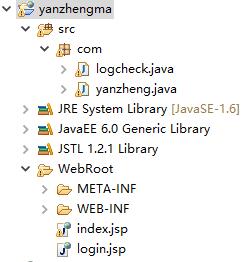驗(yàn)證碼的作用:通常的登錄或者注冊(cè)系統(tǒng)時(shí),都會(huì)要求用戶輸入驗(yàn)證碼,以此區(qū)別用戶行為和計(jì)算機(jī)程序行為,目的是有人防止惡意注冊(cè)、暴力破解密碼等。
實(shí)現(xiàn)驗(yàn)證碼的思路:用 server 實(shí)現(xiàn)隨機(jī)生成數(shù)字和字母組成圖片的功能,用 jsp 頁面實(shí)現(xiàn)顯示驗(yàn)證碼和用戶輸入驗(yàn)證碼的功能,再用 server 類分別獲取圖片和用戶輸入的數(shù)據(jù),判斷兩個(gè)數(shù)據(jù)是否一致。
代碼實(shí)現(xiàn)
1.編寫數(shù)字、英文隨機(jī)生成的 server 類,源碼:
|
1
2
3
4
5
6
7
8
9
10
11
12
13
14
15
16
17
18
19
20
21
22
23
24
25
26
27
28
29
30
31
32
33
34
35
36
37
38
39
40
41
42
43
44
45
46
47
48
49
50
51
52
53
54
55
56
57
58
59
60
61
62
63
64
65
66
67
68
69
70
71
72
73
74
75
76
77
78
79
80
81
82
83
84
85
86
87
88
89
90
91
92
93
94
95
96
97
98
99
100
101
102
103
104
105
106
107
108
109
110
111
112
113
114
|
package com;import java.awt.Color;import java.awt.Font;import java.awt.Graphics;import java.awt.image.BufferedImage;import java.io.ByteArrayOutputStream;import java.io.IOException;import java.io.PrintWriter;import javax.imageio.ImageIO;import javax.servlet.ServletException;import javax.servlet.ServletOutputStream;import javax.servlet.http.HttpServlet;import javax.servlet.http.HttpServletRequest;import javax.servlet.http.HttpServletResponse;import javax.servlet.http.HttpSession;public class logcheck extends HttpServlet { public logcheck() { super(); } public void destroy() { super.destroy(); } public void doGet(HttpServletRequest request, HttpServletResponse response) throws ServletException, IOException { doPost(request, response); } /*實(shí)現(xiàn)的核心代碼*/ public void doPost(HttpServletRequest request, HttpServletResponse response) throws ServletException, IOException { response.setContentType("image/jpeg"); HttpSession session=request.getSession(); int width=60; int height=20; //設(shè)置瀏覽器不要緩存此圖片 response.setHeader("Pragma", "No-cache"); response.setHeader("Cache-Control", "no-cache"); response.setDateHeader("Expires", 0); //創(chuàng)建內(nèi)存圖像并獲得圖形上下文 BufferedImage image=new BufferedImage(width, height,BufferedImage.TYPE_INT_RGB); Graphics g=image.getGraphics(); /* * 產(chǎn)生隨機(jī)驗(yàn)證碼 * 定義驗(yàn)證碼的字符表 */ String chars="0123456789ABCDEFGHIJKLMNOPQRSTUVWXYZ"; char[] rands=new char[4]; for(int i=0;i<4;i++){ int rand=(int) (Math.random() *36); rands[i]=chars.charAt(rand); } /* * 產(chǎn)生圖像 * 畫背景 */ g.setColor(new Color(0xDCDCDC)); g.fillRect(0, 0, width, height); /* * 隨機(jī)產(chǎn)生120個(gè)干擾點(diǎn) */ for(int i=0;i<120;i++){ int x=(int)(Math.random()*width); int y=(int)(Math.random()*height); int red=(int)(Math.random()*255); int green=(int)(Math.random()*255); int blue=(int)(Math.random()*255); g.setColor(new Color(red,green,blue)); g.drawOval(x, y, 1, 0); } g.setColor(Color.BLACK); g.setFont(new Font(null, Font.ITALIC|Font.BOLD,18)); //在不同高度輸出驗(yàn)證碼的不同字符 g.drawString(""+rands[0], 1, 17); g.drawString(""+rands[1], 16, 15); g.drawString(""+rands[2], 31, 18); g.drawString(""+rands[3], 46, 16); g.dispose(); //將圖像傳到客戶端 ServletOutputStream sos=response.getOutputStream(); ByteArrayOutputStream baos=new ByteArrayOutputStream(); ImageIO.write(image, "JPEG", baos); byte[] buffer=baos.toByteArray(); response.setContentLength(buffer.length); sos.write(buffer); baos.close(); sos.close(); session.setAttribute("checkcode", new String(rands)); } public void init() throws ServletException { // Put your code here }} |
2.用于顯示驗(yàn)證碼的頁面:
|
1
2
3
4
5
6
7
8
9
10
11
12
13
14
15
16
17
18
19
20
21
22
23
24
25
26
27
28
29
30
|
<%@ page language="java" import="java.util.*" pageEncoding="UTF-8"%><%String path = request.getContextPath();String basePath = request.getScheme()+"://"+request.getServerName()+":"+request.getServerPort()+path+"/";%><!DOCTYPE HTML PUBLIC "-//W3C//DTD HTML 4.01 Transitional//EN"><html> <head> <base href="<%=basePath%>"> <title>index</title> <meta http-equiv="pragma" content="no-cache"> <meta http-equiv="cache-control" content="no-cache"> <meta http-equiv="expires" content="0"> <meta http-equiv="keywords" content="keyword1,keyword2,keyword3"> <meta http-equiv="description" content="This is my page"> <!-- <link rel="stylesheet" type="text/css" href="styles.css"> --> </head> <body> <form action="yanzheng" method="post"> <input type="text" name="name" size="5" maxlength="4"> <a href="index.jsp"><img border="0" src="logcheck"></a><br><br> <input type="submit" value="提交"> </form> </body></html> |
3.用于檢驗(yàn)輸入的驗(yàn)證碼是否正確:
|
1
2
3
4
5
6
7
8
9
10
11
12
13
14
15
16
17
18
19
20
21
22
23
24
25
26
27
28
29
30
31
32
33
34
35
36
37
38
39
40
41
42
43
44
45
46
47
48
49
50
51
52
53
54
55
56
|
package com;import java.io.IOException;import java.io.PrintWriter;import javax.jms.Session;import javax.servlet.ServletException;import javax.servlet.http.HttpServlet;import javax.servlet.http.HttpServletRequest;import javax.servlet.http.HttpServletResponse;import javax.servlet.http.HttpSession;public class yanzheng extends HttpServlet { public yanzheng() { super(); } public void destroy() { super.destroy(); } public void doGet(HttpServletRequest request, HttpServletResponse response) throws ServletException, IOException { doPost(request, response); } /*核心代碼*/ public void doPost(HttpServletRequest request, HttpServletResponse response) throws ServletException, IOException { String info=null; /*獲取輸入的值*/ String value1=request.getParameter("name"); /*獲取圖片的值*/ HttpSession session=request.getSession(); String value2=(String)session.getAttribute("checkcode"); /*對(duì)比兩個(gè)值(字母不區(qū)分大小寫)*/ if(value2.equalsIgnoreCase(value1)){ info="驗(yàn)證碼輸入正確"; }else{ info="驗(yàn)證碼輸入錯(cuò)誤"; } System.out.println(info); request.setAttribute("info", info); request.getRequestDispatcher("/login.jsp").forward(request, response); } public void init() throws ServletException { // Put your code here }} |
4.顯示輸入結(jié)構(gòu)界面(輸入驗(yàn)證碼是否正確):
|
1
2
3
4
5
6
7
8
9
10
11
12
13
14
15
16
17
18
19
20
21
22
23
24
25
26
27
28
|
<%@ page language="java" import="java.util.*" pageEncoding="UTF-8"%><%String path = request.getContextPath();String basePath = request.getScheme()+"://"+request.getServerName()+":"+request.getServerPort()+path+"/";%><!DOCTYPE HTML PUBLIC "-//W3C//DTD HTML 4.01 Transitional//EN"><html> <head> <base href="<%=basePath%>"> <title>My JSP 'login.jsp' starting page</title> <meta http-equiv="pragma" content="no-cache"> <meta http-equiv="cache-control" content="no-cache"> <meta http-equiv="expires" content="0"> <meta http-equiv="keywords" content="keyword1,keyword2,keyword3"> <meta http-equiv="description" content="This is my page"> <!-- <link rel="stylesheet" type="text/css" href="styles.css"> --> </head> <body> <%=request.getAttribute("info") %> </body></html> |
5.項(xiàng)目結(jié)構(gòu)、效果截圖:


以上就是本文的全部內(nèi)容,希望對(duì)大家的學(xué)習(xí)有所幫助,也希望大家多多支持服務(wù)器之家。











